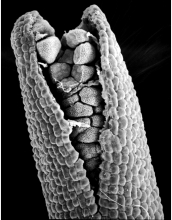Multimedia Gallery
SEM of Partially Opened Spore
A scanning electron micrograph (SEM) of a spore stalk that's partially open from a hornwort Dendroceros crispata. The hornwort is one of many species of plants that scientists are studying as part of the National Science Foundation-supported "Tree of Life" initiative. The goal of the initiative is to reconstruct the evolutionary history of early land plants, as well as to answer such questions as how multicellular aquatic plants evolved, what plants first colonized land, how are the early plant lineages related to each other, and what genetic, cellular and structural changes did they undergo. [This research was supported by a grant from the Assembling Tree of Life initiative and from three systematic biology grants.] [Image 7 of 8 related images. See Image 8.]
More about this Image
The National Science Foundation (NSF) has awarded some $17 million to seven research teams to begin a massive project in biodiversity--assembling a complete "Tree of Life," a map of the evolutionary history of all Earth's species, past and present.
Karen S. Renzaglia of Southern Illinois University at Carbondale (SIUC) received an NSF grant to study green plant evolution. Working in collaboration with other scientists at SIUC and with several principal investigators from other institutions, Renzaglia is reconstructing in detail, the family tree of the plant kingdom. The "genealogical" study is focusing on plant groups with an ancient heritage, such as algae, mosses and ferns, where evolutionary relationships are unclear and where the most dramatic biological changes must have occured.
Renzaglia studies cell-level changes in early land plants. The earliest plants to make the transition to land are still the smallest--mosses, liverworts and hornworts. Called bryophytes, these plants are found on every continent but Antarctica. They hug the ground, absorbing water and nutrients directly through their cells and skinny threads called rhizoids (an early form of a root) anchor them to the soil. It wasn't until plants evolved true root systems and veins to carry water and nutrients--like the giant tree ferns and rush-like horsetails and club mosses, called pteridophytes (Greek for "fern plants")--that they were able to grow larger. Not much more is known for certain about early plant evolution.
In a separate project also supported by NSF, Renzaglia and biologist Joel Duff of the University of Akron are piecing together the family tree of the world's 150 or so kinds of hornworts. Renzaglia says there is so little information about hornworts at this time that it's hard to know what defines a species or genus. She believes that hornworts were the earliest land plant that still exists today. Renzaglia and other teams of researchers will conduct in-depth analysis of about 50 species of plants that they believe represent major lineages among green algae, bryophytes and pteridophytes.
To understand all the developmental stages of these plants, Renzaglia and her students are examining spores and spore capsules, egg and sperm cells, embryos, and mature plants; documenting dozens of characteristics; photographing specimens; comparing and compiling details previously reported about the species in the scientific literature; and archiving everything they find. The research is long and drawn out. For example, data collected on spores includes their shape and color, their "ornamentation" (whorls and ridges), their internal structure and development, and what types of molecules, such as proteins and sugars, are stored inside. The team will develop new methods of organizing, combining and analyzing diverse data sets to draw conclusions about evolutionary history.
Obtaining the details of plant evolution will involve a combination of fossil, genetic and morphological evidence, but Renzaglia thinks it has the potential to uncover all kinds of new information and "open up a world nobody's known about." (Year of image: 2002)
Credit: Photo by Karen Renzaglia; courtesy Dan Nickrent
Images and other media in the National Science Foundation Multimedia Gallery are available for use in print and electronic material by NSF employees, members of the media, university staff, teachers and the general public. All media in the gallery are intended for personal, educational and nonprofit/non-commercial use only.
Images credited to the National Science Foundation, a federal agency, are in the public domain. The images were created by employees of the United States Government as part of their official duties or prepared by contractors as "works for hire" for NSF. You may freely use NSF-credited images and, at your discretion, credit NSF with a "Courtesy: National Science Foundation" notation.
Additional information about general usage can be found in Conditions.
Also Available:
Download the high-resolution TIFF version of the image. (8 MB)
Use your mouse to right-click (Mac users may need to Ctrl-click) the link above and choose the option that will save the file or target to your computer.

